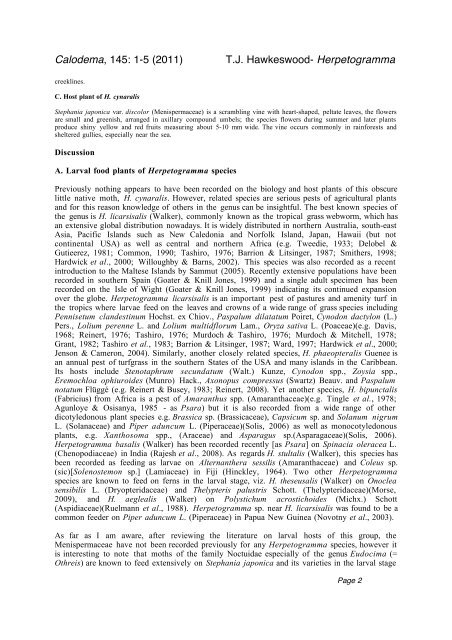Herpetogramma paper.cwk (WP) - Calodema
Herpetogramma paper.cwk (WP) - Calodema
Herpetogramma paper.cwk (WP) - Calodema
Create successful ePaper yourself
Turn your PDF publications into a flip-book with our unique Google optimized e-Paper software.
<strong>Calodema</strong>, 145: 1-5 (2011)T.J. Hawkeswood- <strong>Herpetogramma</strong>creeklines.C. Host plant of H. cynaralisStephania japonica var. discolor (Menispermaceae) is a scrambling vine with heart-shaped, peltate leaves, the flowersare small and greenish, arranged in axillary compound umbels; the species flowers during summer and later plantsproduce shiny yellow and red fruits measuring about 5-10 mm wide. The vine occurs commonly in rainforests andsheltered gullies, especially near the sea.DiscussionA. Larval food plants of <strong>Herpetogramma</strong> speciesPreviously nothing appears to have been recorded on the biology and host plants of this obscurelittle native moth, H. cynaralis. However, related species are serious pests of agricultural plantsand for this reason knowledge of others in the genus can be insightful. The best known species ofthe genus is H. licarsisalis (Walker), commonly known as the tropical grass webworm, which hasan extensive global distribution nowadays. It is widely distributed in northern Australia, south-eastAsia, Pacific Islands such as New Caledonia and Norfolk Island, Japan, Hawaii (but notcontinental USA) as well as central and northern Africa (e.g. Tweedie, 1933; Delobel &Gutieerez, 1981; Common, 1990; Tashiro, 1976; Barrion & Litsinger, 1987; Smithers, 1998;Hardwick et al., 2000; Willoughby & Barns, 2002). This species was also recorded as a recentintroduction to the Maltese Islands by Sammut (2005). Recently extensive populations have beenrecorded in southern Spain (Goater & Knill Jones, 1999) and a single adult specimen has beenrecorded on the Isle of Wight (Goater & Knill Jones, 1999) indicating its continued expansionover the globe. <strong>Herpetogramma</strong> licarsisalis is an important pest of pastures and amenity turf inthe tropics where larvae feed on the leaves and crowns of a wide range of grass species includingPennisetum clandestinum Hochst. ex Chiov., Paspalum dilatatum Poiret, Cynodon dactylon (L.)Pers., Lolium perenne L. and Lolium multidflorum Lam., Oryza sativa L. (Poaceae)(e.g. Davis,1968; Reinert, 1976; Tashiro, 1976; Murdoch & Tashiro, 1976; Murdoch & Mitchell, 1978;Grant, 1982; Tashiro et al., 1983; Barrion & Litsinger, 1987; Ward, 1997; Hardwick et al., 2000;Jenson & Cameron, 2004). Similarly, another closely related species, H. phaeopteralis Guenee isan annual pest of turfgrass in the southern States of the USA and many islands in the Caribbean.Its hosts include Stenotaphrum secundatum (Walt.) Kunze, Cynodon spp., Zoysia spp.,Eremochloa ophiuroides (Munro) Hack., Axonopus compressus (Swartz) Beauv. and Paspalumnotatum Flüggé (e.g. Reinert & Busey, 1983; Reinert, 2008). Yet another species, H. bipunctalis(Fabricius) from Africa is a pest of Amaranthus spp. (Amaranthaceae)(e.g. Tingle et al., 1978;Agunloye & Osisanya, 1985 - as Psara) but it is also recorded from a wide range of otherdicotyledonous plant species e.g. Brassica sp. (Brassicaceae), Capsicum sp. and Solanum nigrumL. (Solanaceae) and Piper aduncum L. (Piperaceae)(Solis, 2006) as well as monocotyledonousplants, e.g. Xanthosoma spp., (Araceae) and Asparagus sp.(Asparagaceae)(Solis, 2006).<strong>Herpetogramma</strong> basalis (Walker) has been recorded recently [as Psara] on Spinacia oleracea L.(Chenopodiaceae) in India (Rajesh et al., 2008). As regards H. stultalis (Walker), this species hasbeen recorded as feeding as larvae on Alternanthera sessilis (Amaranthaceae) and Coleus sp.(sic)[Solenostemon sp.] (Lamiaceae) in Fiji (Hinckley, 1964). Two other <strong>Herpetogramma</strong>species are known to feed on ferns in the larval stage, viz. H. theseusalis (Walker) on Onocleasensibilis L. (Dryopteridaceae) and Thelypteris palustris Schott. (Thelypteridaceae)(Morse,2009), and H. aeglealis (Walker) on Polystichum acrostichoides (Michx.) Schott(Aspidiaceae)(Ruelmann et al., 1988). <strong>Herpetogramma</strong> sp. near H. licarsisalis was found to be acommon feeder on Piper aduncum L. (Piperaceae) in Papua New Guinea (Novotny et al., 2003).As far as I am aware, after reviewing the literature on larval hosts of this group, theMenispermaceae have not been recorded previously for any <strong>Herpetogramma</strong> species, however itis interesting to note that moths of the family Noctuidae especially of the genus Eudocima (=Othreis) are known to feed extensively on Stephania japonica and its varieties in the larval stagePage 2
















